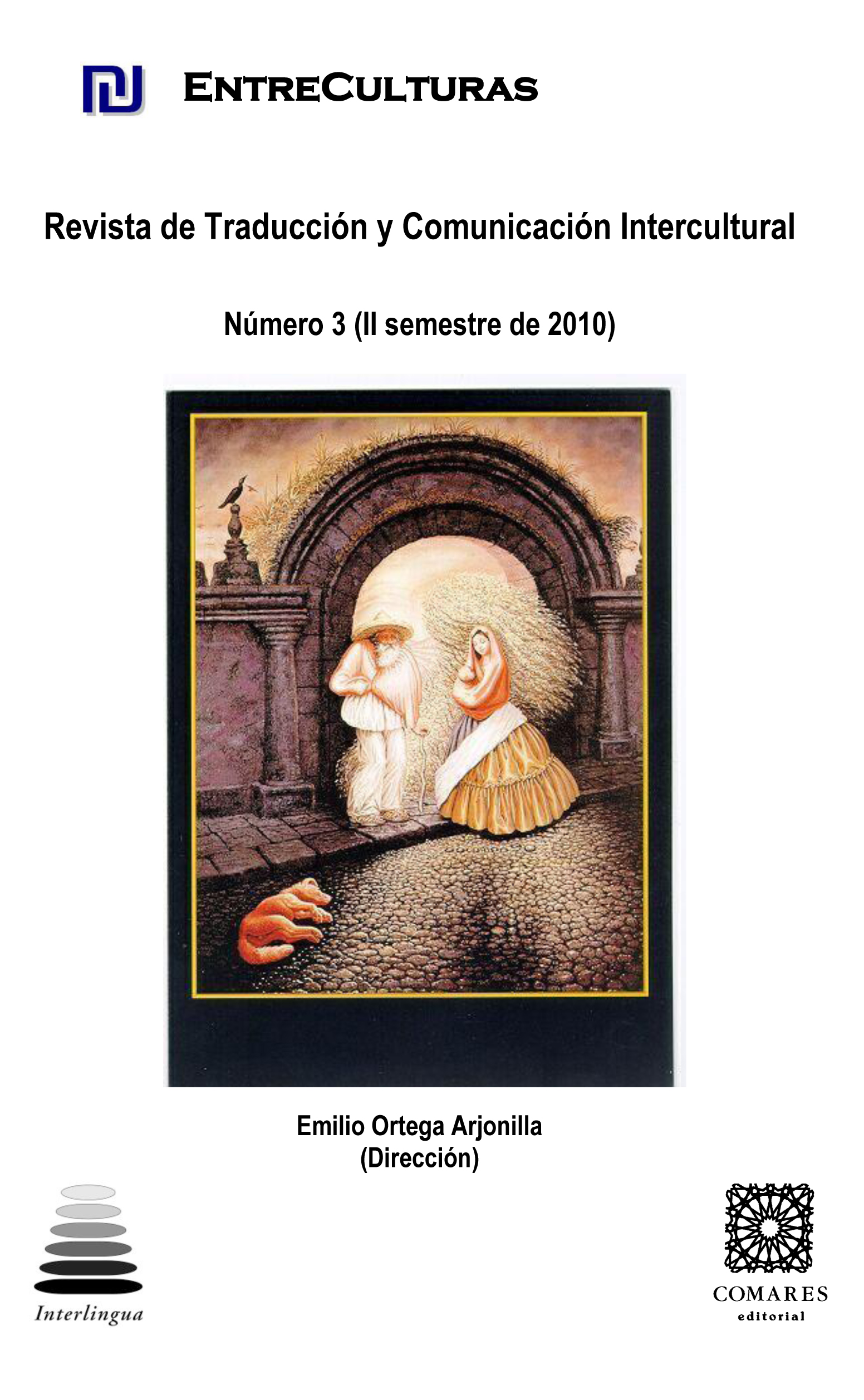LA TRADUCCIÓN DE LA ESPECIFICIDAD DEL TEXTO TEATRAL: LA SIMBOLOGÍA EN A MAN FOR ALL SEASONS
DOI:
https://doi.org/10.24310/Entreculturasertci.vi3.11623Palabras clave:
traducción de teatro, lenguaje simbólico, referente cultural, elementos verbalesResumen
La literatura sobre traducción teatral plantea la pertinencia de realizar dos tipos de traducción: la traducción for the page (para la publicación) o la traducción for the stage (para el escenario). Independientemente del uso final que se haga del texto dramático, su traducción plantea ciertas dificultades, ya que posee unos rasgos específicos como la dualidad del texto dramático, compuesto por el texto literario y el marco escénico. En la dramática de Bolt destaca tanto el exhaustivo trabajo de documentación histórica para la elaboración de la obra, como la utilización del lenguaje simbólico para representar el contexto suprahumano que envuelve la acción y aludir a estos hechos históricos. Como consecuencia, encontramos una doble problemática: la existencia de un desequilibrio entre el universo del conocimiento del lector de la cultura origen y el de la cultura meta, y, que es sobre este sustrato sobre el que Bolt ha construido su lenguaje simbólico.
Descargas
Métricas
Citas
AALTONEN, S (2000): Time-Sharing on Stage. Drama Translation in Theatre and Society. Clevedon, Multilingual Matters.
ANDERMAN, G (1998): "Drama translation"en M. Baker y K. Malmkjaer (eds.): Routledge Encyclopedia of Translation Studies. Londres & Nueva York: Routledge, 71-74.
BASSNETT, S. (1985): "Ways through the labyrinth: strategies and methods for translating theatre texts" en T. Hermans (ed.): The Manipulation of Literary Studies in Literary Translation. Londres: Croom Helm, 87-103.
? (1991): "Translating for the Theatre: The Case against Performability". Traduction, Terminologie, Redaction, n.º 4 (1), 99-111. [Consultado en junio de 2007] htttp://iderudit.org/iderudit/037084ar
? (2002): Translation studies. Nueva York: Routledge.
BOLT, R (1967): Un hombre para la eternidad. A Man for All Seasons. (Traducido por Luis Escobar) Madrid, Ediciones Iberoamericanas.
? (1969): A Man for All Seasons. Nueva York: Vintage International.
COLLINS COBUILD ENGLISH DICTIONARY FOR ADVANCED LEARNERS (2001). Third Edition. Glasgow, Harper Collins Publishers.
ESPASA, E. (2001): La Traducció dalt de l’escenari. Barcelona, Eumo.
LEFEVERE, A (1980): "Translating literature/translated literature: the state of the art" en O. Zuber (ed.): The Languages of Theatre. Oxford, Pergamon Press, 153-161.
? (1984): "Refraction: some observations on the occasion of Wole Soyinska‘ s Opera Wonyosi" en O. Zuber-Skerritt, ed. (1984): Page to Stage. Theatre as Translation. Ámsterdam, Rodopi.
? (1992): Translation, Rewriting and the Manipulation of Literary Frame. Londres & Nueva York: Routledge.
MCAULEY, G (1995): "Translation in the performance process". About Performance, Working Papers Vol. 1, Centre for Performance Studies. Sidney, University of Sydney, 111-125.
MARIUS, R. (1983): Thomas More. A Biography. Cambridge, Harvard University Press.
MERINO ÁLVAREZ, R (1994): Traducción, tradición y manipulación. El teatro inglés en España 1950-1990. León, Secretariado de publicaciones de la Universidad de León.
? (1995): "La traducción del teatro inglés en España: cuarenta años de plagios" en P. Fernández Nistal y J. M. Bravo González (eds.): Perspectivas de la traducción inglés/español. Valladolid, Universidad de Valladolid, 75-89.
PAVIS, P (1989): "Problems of translation for the stage: interculturalism and post-modern theatre" en H. Scolnicov y P. Holland (eds.): The Play out of Context. Transferring plays from culture to culture. Cambridge, Cambridge University Press.
RIDLEY, J. (1994): Henry VIII. Londres, Penguin Books.
SANTOYO, J. C (1995): "Reflexiones, teoría y crítica de la traducción dramática. Panorama desde el páramo español" en F. Lafarga y R. Dengler: Teatro y traducción. Barcelona, Universidad Pompeu Fabra.
SHAKED, G (1989): "The play: gateway to cultural dialogue" en H. Scolnicov & P. Holland (eds.): The Play out of context. Transferring plays from culture to culture. Cambridge, Cambridge University Press, 7-24.
SNELL-HORNBY, M. (2006): The turns of translation studies. Ámsterdam, John Benjamins.
TÖRNQVIST, E. (1991): El teatro en otra lengua y otro medio. Madrid: Arco (traducción de M. Mateo Martínez-Bartolomé).
WEIR, A. (2001): Henry VIII, the King and his Court. Nueva York, Ballantine.
ZATLIN, P (2005): Theatrical Translation and Film Adaptation. A Practitioner’s View. Clevedon, Multilingual Matters.
ZUBER, O. (ed.) (1980): The Languages of Theatre: Problems in the Translation and Transposition of Drama. Oxford, Pergamon Press.
ZUBER-SKERRITT, O. (ed.) (1984): Page to Stage. Theatre as Translation. Ámsterdam: Rodopi.
Descargas
Publicado
Cómo citar
Número
Sección
Licencia
Todos los contenidos publicados en Entreculturas. Revista de traducción y comunicación intercultural están sujetos a la licencia Creative Commons Reconocimento-NoComercia-Compartirigual 4.0 cuyo texto completo puede consultar en <http://creativecommons.org/licenses/by-nc-sa/4.0>
- Se pueden copiar, usar, difundir, transmitir y exponer públicamente, siempre que:
- Se cite la autoría y la fuente original de su publicación (revista, editorial y URL de la obra).
- No se usen para fines comerciales.
- Se mencione la existencia y especificaciones de esta licencia de uso.
Los derechos de autor son de dos clases: morales y patrimoniales. Los derechos morales son prerrogativas perpetuas, irrenunciables, intransferibles, inalienables, inembargables e imprescriptibles. De acuerdo con la legislación de derechos de autor, Entreculturas. Revista de traducción y comunicación intercultural reconoce y respeta el derecho moral de los autores/as, así como la titularidad del derecho patrimonial, el cual será cedido a la Universidad de Málaga para su difusión en acceso abierto. Los derechos patrimoniales, se refieren a los beneficios que se obtienen por el uso o divulgación de las obras. Entreculturas. Revista de traducción y comunicación se publica en open access y queda autorizada en exclusiva para realizar u autorizar por cualquier medio el uso, distribución, divulgación, reproducción, adaptación, traducción o transformación de la obra.
Es responsabilidad de los autores/as obtener los permisos necesarios de las imágenes que están sujetas a derechos de autor.





7.png)
